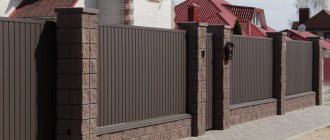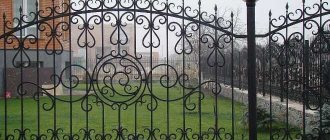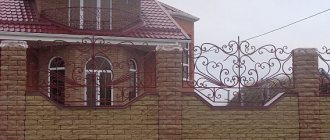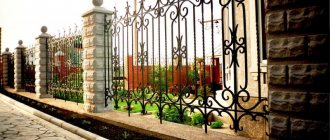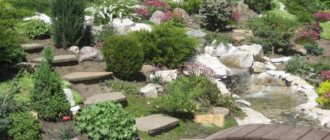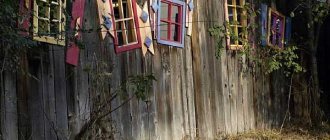Forged or welded
Welded and forged fences and gates are made from the same material, but use different technologies. In both cases, the elasticity of the metal is used. But it is used in different ways, in different conditions and processes. During the forging process, a metal blank (a rod is usually used for fences) is heated, brought to a certain temperature, and pressed to give it the desired shape. The variety of shapes is great: heated metal becomes many times more plastic, which makes it possible to forge openwork and twisted elements from it.
Having collected a certain number of forged blanks, they are combined into sections, which are then mounted on support pillars. Due to the fact that the work is carried out with softened metal, it is possible to combine the elements of the fence into a single whole almost without seams. Due to this, the forged fence looks very neat.
Classic forging is a long and expensive process, but the fence turns out to be unique
When creating welded fences, the elasticity of the metal is also used, but in a cold state. Twisted and curved elements are also made from rods - the process is called “cold forging”. To obtain welded fence elements of different shapes, there are special devices that allow you to change the shape of the workpieces without heating. But, in a cold state, the ductility of the metal is less, and there are fewer possible variations.
When creating welded fences, the elements are combined by welding. This causes the presence of welded seams. This - the lower artistic value and the presence of seams - is the main difference between welded and forged fences. Otherwise (functionality, durability) they are the same. What else is the difference? In price and production time. Forged fences and gates require much more time to manufacture and cost more, since the process requires special skills and high qualifications. Welded ones are faster and easier to make, and therefore the price is lower.
Forged-welded fences are not so expensive and look interesting
There is also an intermediate type - forged-welded fences. In them, the elements are made by forging, and in sections they are assembled and fastened to each other by welding. Such fences look no less presentable than forged ones, and are cheaper, since the manufacturing process is less labor-intensive.
Types of forged fences
We will talk about what materials are used in combination to make forged fences and gates. It’s no secret that metal lace is too transparent and serves only as a physical barrier, and only if the sections are of a considerable height. To block the courtyard from view, it is necessary to place an opaque material behind the wrought iron weave. We will talk about what to combine a wrought iron fence with.
Another example of a classic forged fence
Posts for forged and welded fences
Forged or welded sections of a metal fence can be mounted on metal or brick (stone) pillars. These are the two types of support that are used in most cases. If you are going to make a combined type of fence (an opaque material is installed behind the forged section), the best option is with brick pillars. The windage of the combined fence is high, and such a base will be reliable and will withstand any wind.
Something similar can be done using cold forging.
Looking at this, you understand what the difference is
Monumental...
So many different elements...
Floral motifs are very popular. You can't make them with cold forging
Metal pillars and forged sections on a stone foundation
Finials and decorative elements turn a simple lattice into a decorative item
One of the simpler options
The pillars themselves are a work of art.
For the main entrance
Forged twisted elements closer
There is another common option - a stone foundation into which metal pillars are mounted. This option for a fence can be considered optimal: it is not as heavy as with stone pillars, but, at the same time, reliable.
With metal or corrugated sheet
Quite often you can find a combination of a forged fence section with a painted metal sheet installed at the back. As an option, corrugated roofing sheets can be used. It has a factory paint job that is designed to withstand the elements. In this case, the forged elements are painted black, and the color of the metal behind it is matched to the color of the roof of the house or cottage.
It is not necessary to make a lattice
Combined fence made of forged sections and corrugated sheets
Beautiful wrought iron gates
A truly monumental building
Against the background of green corrugated sheet
Another cold forged fence with welded joints with burgundy-colored corrugated sheets
But the profiled sheet has a formed relief, which not everyone likes in combination with forging. In this case, use a sheet of metal. But it must be carefully treated with anti-corrosion compounds, coated with a primer and only then painted. In this case, the appearance of the metal will be preserved for a long time. This option is good because you can choose any color you like: bronze, silver, some unusual shade.
The combination of a forged fence with a metal sheet results in a very reliable fence. The strength of the metal sheet is enhanced by a grid of forged rods. In addition, it turns out organically and beautifully. Openwork forged bindings against a colored background look bright and impressive.
With polycarbonate
Often wrought iron fences and gates are supplemented with polycarbonate. This material is not only cellular, but also sheet. Sheet is more durable and can withstand even a blow from a stone, and some models are bulletproof and are used in banks. Although the interweaving of the fence rods does not require special strength, such material can be a salvation from vandals.
The beauty of classic forging is emphasized by polycarbonate sheet
No need to sew everything up
It is rather a polycarbonate fence with forging elements
Welded fence and polycarbonate
The central part of the openwork is highlighted in color
Brown is the most popular color
Colored polycarbonate inserts are an interesting option
Another option
If you have taste and imagination, you can make interesting fences from just a few details
Bronze polycarbonate highlights the design well
Polycarbonate can be painted in different colors. The most commonly used colors are matte white or with a slight tint, while brown and bronze are also popular. Even when colored in bulk, they are translucent. Behind such a fence, movement can be discerned, but details and details cannot be seen.
Polycarbonate of any type is easy to cut, so it can be used to decorate only certain parts of the fence, for example, you can make colored inserts.
With a tree
The wood itself is both decorative and strong enough to create fences. Wooden fences and gates are a large group, but in combination with forged elements they turn out even more beautiful.
There are two options for forged or welded fences with wood. The first is a forged metal frame with sparsely spaced metal elements. This frame is filled with densely spaced boards. It’s difficult to say which material is the main one. If we take it by quantity, then it is wood, but the frame is made of metal, which unites everything, although the metal part itself cannot be a fence: the weave is too sparse. Sometimes it's just a frame around the perimeter and patterns on top/bottom. By the way, the fences they make are interesting. Many look like fairy tales - they will go perfectly with a wooden house.
Representative of the second type - forged gates and fences covered with boards
The symbiosis of metal and wood - it turns out beautifully
Just out of a fairy tale...
A more familiar option, but no less beautiful
Metal frame filled with board
Styles may vary
Traditional forging can also be supplemented with wood
One more style
Simple but stylish
That rare case when a tree is just for decoration
The second type is sections of a full-fledged forged fence, covered with boards on the back side (from the yard side). In rare cases, boards are inserted into metal frames. The main difference is that a metal frame can be a fence without boards; they are just an addition.
Types of forged gates
When choosing a fence for your site, you also need to think in advance about which gate is best suited to it. You can make the main gate to match the style of the overall design or a slightly contrasting option. In this case, a wide field for flight of fancy is open.
Fine handmade
Traditionally, gates are made from several types of material:
- steel – is flexible, thanks to which you can create the most intricate designs and ornaments;
- cast iron is durable due to the combination of carbon and iron.
The process of making iron gates differs depending on what material is chosen for it. In the case of cast iron, some individual parts are first cast, which are eventually assembled into a finished product. This method is called hot forging; it is more technically complex and expensive.
The photo shows a forged gate.
Beautiful gate
For steel elements, simple cold forging technology is used. In this case, individual metal elements acquire the desired shape due to strong mechanical stress. This method is less labor-intensive and not too expensive.
Today, you can implement various variations of forged gates. For example, openwork gates with a metal pattern. Such structures are transparent.
Massiveness and grandeur
If you want to hide the decoration of the site from view, use combined-type structures similar to those listed above. In this case, a forged metal base will add rigidity to the gate, and a decorative base in the form of wood, corrugated sheet or polycarbonate will hide the courtyard from prying eyes. Such models of gates look no less attractive than solid forged structures.
Private house under reliable protection
By the way, in some cases it is not necessary to cover the gate with a corrugated sheet; you can do it differently. For example, close the gate with climbing plants. The result is a beautiful and harmonious design, but it must be properly looked after.
Metal products
Types of gate designs
Forged gates not only differ in external features, but also in the type of construction, the list of which includes:
- Hinged doors are the classic and most common type of structure, the doors of which can open both outward and inward.
- Sliding ones are similar to the previous type, but they have one significant advantage - they save usable space on the site.
- Lifting ones allow you to free up space as much as possible due to the specific design of this design.
- Fully automated gates are the most expensive of the above. They are easy to use thanks to a fully automated opening and closing process.
Schemes and sketches for welded and forged fences and enclosures
Owning your own home forces you to gain knowledge in various areas - even if you don’t do everything yourself, it is very desirable to supervise the work of hired workers. Then the result is guaranteed to be at least not below average. And you generally have to choose the style, design and other individual things yourself, otherwise designers will do what they think is fashionable or beautiful.
For inspiration, we have collected a number of sketches and diagrams of forged fences. Some of them are simpler, some are very individual. For the former, it’s not difficult to find performers, but if you want to order a fence from those that are “more complicated,” you’ll have to search. And it’s better to at least see a couple of samples with your own eyes.
It can be traditional or cold forging
Sketches of forged fences
More complex options
This is forging of the traditional type, and delicate work at that
The main emphasis is on the upper part
More geometric option
Forged polycarbonate gate project
Just a palace style
Only for a pompous mansion
Photos of beautiful and unusual wrought iron fences
It’s not for nothing that sculptures are made from metal. The material is very plastic, durable, allowing you to realize any fantasies and ideas. Looking at photos of some forged fences and gates, you often wonder: is this just a fence, or an object of artistic value?
It's beautiful... Isn't it?
Song in metal
And the gate itself, and the fence, and the pillars, and the arch of the gate - everything is very, very beautiful
The beauty of the design is emphasized by well-chosen paint.
For an impressive cottage
Unusual option
Rural sketches on metal
Apparently someone loves stories about dragons
Metallic lace
A welded fence doesn’t mean boring
After all, traditional forging is for serious people
It turns out that not only embossing makes it possible to create paintings in metal
And don’t take your eyes off!
This will definitely be remembered
Installation instructions
Proper installation of a wrought-iron wooden fence is carried out in accordance with certain rules:
- The territory is being marked.
- Ground work is being carried out.
- The formwork is being installed.
- The concrete mixture is being prepared.
- Pillars are installed at a given pitch.
- Concrete is compacted.
- Irregularities are eliminated.
- Time is allowed (about a day) for the concrete to harden.
- The base part and pillars are covered with stone.
- The veins made of wood are attached to the posts.
- Using self-tapping screws, a picket fence is attached to the veins.
The finished fence is reinforced or decorated with forging , and, if necessary, coated with paint to create an original color.
